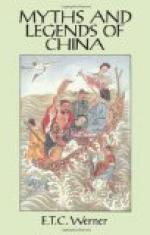Though the origin of the name ‘China’ has not yet been finally decided, the best authorities regard it as derived from the name of this feudal state of Ch’in.
Under this short-lived dynasty of Ch’in and the famous Han dynasty (221 B.C. to A.D. 221) which followed it, the Empire expanded until it embraced almost all the territory now known as China Proper (the Eighteen Provinces of Manchu times). To these were added in order between 194 B.C. and A.D. 1414: Corea, Sinkiang (the New Territory or Eastern Turkestan), Manchuria, Formosa, Tibet, and Mongolia—Formosa and Corea being annexed by Japan in 1895 and 1910 respectively. Numerous other extra-China countries and islands, acquired and lost during the long course of Chinese history (at one time, from 73 to 48 B.C., “all Asia from Japan to the Caspian Sea was tributary to the Middle Kingdom,” i.e. China), it is not necessary to mention here. During the Southern Sung dynasty (1127-1280) the Tartars owned the northern half of China, as far down as the Yangtzu River, and in the Yuean dynasty (1280-1368) they conquered the whole country. During the period 1644-1912 it was in the possession of the Manchus. At present the five chief component peoples of China are represented in the striped national flag (from the top downward) by red (Manchus), yellow (Chinese), blue (Mongolians), white (Mohammedans), and black (Tibetans). This flag was adopted on the establishment of the Republic in 1912, and supplanted the triangular Dragon flag previously in use. By this time the population—which had varied considerably at different periods owing to war, famine, and pestilence—had increased to about 400,000,000.
General Government
The general division of the nation was into the King and the People, The former was regarded as appointed by the will of Heaven and as the parent of the latter. Besides being king, he was also law-giver, commander-in-chief of the armies, high priest, and master of ceremonies. The people were divided into four classes: (1) Shih, Officers (later Scholars), consisting of Ch’en, Officials (a few of whom were ennobled), and Shen Shih, Gentry; (2) Nung, Agriculturists; (3) Kung, Artisans; and (4) Shang, Merchants.
For administrative purposes there were at the seat of central government (which, first at P’ing-yang—in modern Shansi—was moved eleven times during the Feudal Period, and was finally at Yin) ministers, or ministers and a hierarchy of officials, the country being divided into provinces, varying in number from nine in the earliest times to thirty-six under the First Emperor, 221 B.C., and finally twenty-two at the present day. At first these provinces contained states, which were models of the central state, the ruler’s ‘Middle Kingdom.’ The provincial administration was in the hands of twelve Pastors or Lord-Lieutenants. They were the chiefs




